

Compact Muon Solenoid
LHC, CERN
| CMS-PAS-EXO-21-008 | ||
| Search for long-lived particles decaying in the CMS muon detectors in proton-proton collisions at $ \sqrt{s}= $ 13 TeV | ||
| CMS Collaboration | ||
| 12 July 2023 | ||
| Abstract: A search for long-lived particles (LLPs) decaying in the CMS muon detectors is presented. The data sample consists of 138 fb$ ^{-1} $ of proton-proton collisions at $ \sqrt{s}= $ 13 TeV, recorded at the LHC in 2016-2018. A unique technique is employed to reconstruct decays of LLPs in the muon detectors. The search is sensitive to LLP masses from 0.4 to 55 GeV and a broad range of LLP decay modes, including decays to a pair of quarks, kaons, pions, electrons, photons, or $ \tau $ leptons. No excess of events above the standard model background is observed. The most stringent LHC limits to date on the branching fraction of the Higgs boson to a pair of LLPs with masses below 10 GeV are set. This search also provides the most stringent limit for proper decay lengths in the range 0.04-0.4 m and above 4 m for an LLP mass of 15 GeV, in the range 0.3-0.9 m and above 3 m for an LLP mass of 40 GeV, and above 0.8 m for an LLP mass of 55 GeV. Finally, this search sets the first LHC limits on a dark quantum chromodynamic sector that couples to the Higgs boson through gluon, Higgs, photon, vector, and dark photon portals, and is sensitive to branching fractions of the Higgs boson to dark quarks as low as 10$^{-3} $. | ||
|
Links:
CDS record (PDF) ;
Physics Briefing ;
CADI line (restricted) ;
These preliminary results are superseded in this paper, Submitted to JHEP. The superseded preliminary plots can be found here. |
||
| Figures & Tables | Summary | Additional Figures | References | CMS Publications |
|---|
| Figures | |
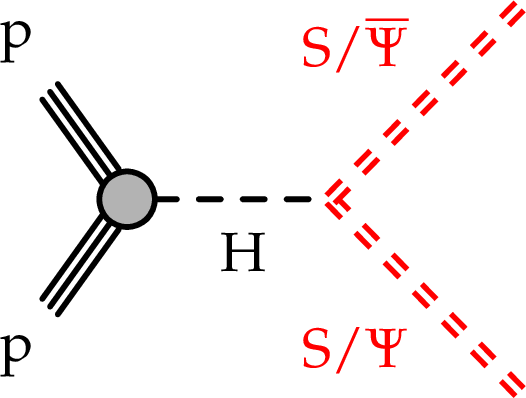
png pdf |
Figure 1:
Diagram of twin Higgs model and dark shower model. The SM Higgs boson decays to a pair of neutral long-lived scalars (S) in the twin Higgs model or to a pair of dark sector quarks ($ \Psi $) in the dark shower model. |
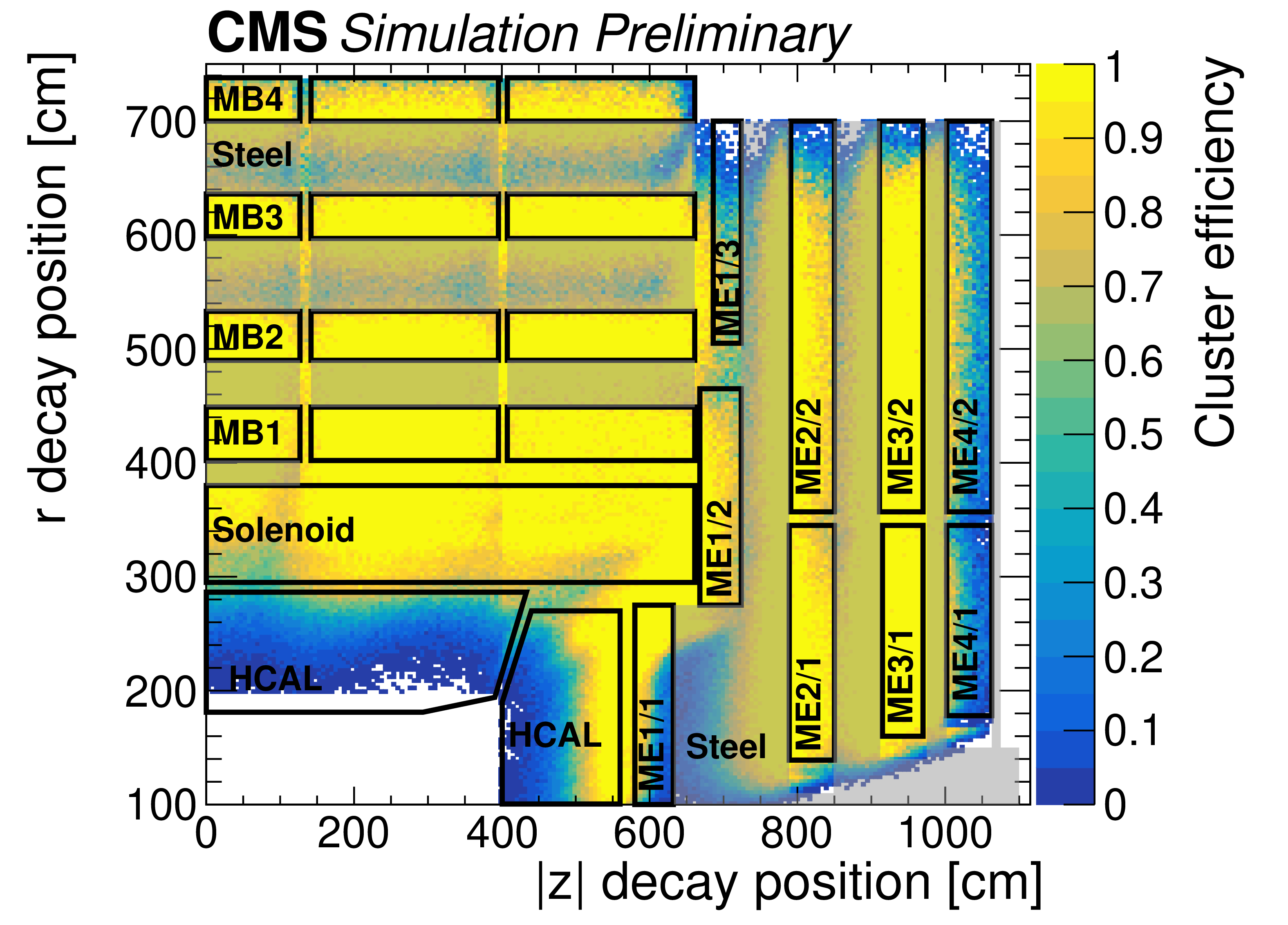
png pdf |
Figure 2:
The cluster reconstruction efficiencies, including both DT and CSC clusters, as a function of the simulated $ r $ and $ |z| $ decay positions of the particle S decaying to $ \mathrm{d}\overline{\mathrm{d}} $, for a mass of 40 GeV and a range of $ c\tau $ values between 1 and 10 m. The barrel and endcap muon stations are drawn as black boxes and labeled by their station names. Regions occupied by steel shielding are shaded in gray. |
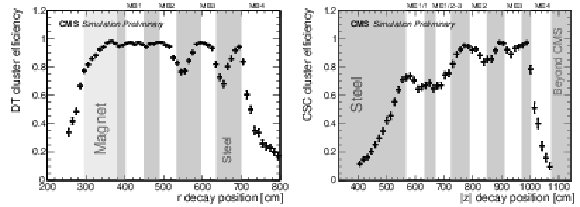
png pdf |
Figure 3:
The DT (left) and CSC (right) cluster reconstruction efficiency as a function of the simulated $ r $ or $ |z| $ decay positions of S decaying to $ \mathrm{d}\overline{\mathrm{d}} $, for a mass of 40 GeV and a range of $ c\tau $ values between 1 and 10 m. Regions occupied by steel shielding are shaded in gray. |

png pdf |
Figure 3-a:
The DT (left) and CSC (right) cluster reconstruction efficiency as a function of the simulated $ r $ or $ |z| $ decay positions of S decaying to $ \mathrm{d}\overline{\mathrm{d}} $, for a mass of 40 GeV and a range of $ c\tau $ values between 1 and 10 m. Regions occupied by steel shielding are shaded in gray. |
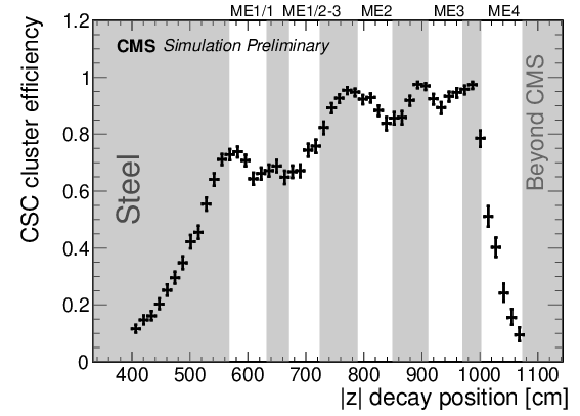
png pdf |
Figure 3-b:
The DT (left) and CSC (right) cluster reconstruction efficiency as a function of the simulated $ r $ or $ |z| $ decay positions of S decaying to $ \mathrm{d}\overline{\mathrm{d}} $, for a mass of 40 GeV and a range of $ c\tau $ values between 1 and 10 m. Regions occupied by steel shielding are shaded in gray. |
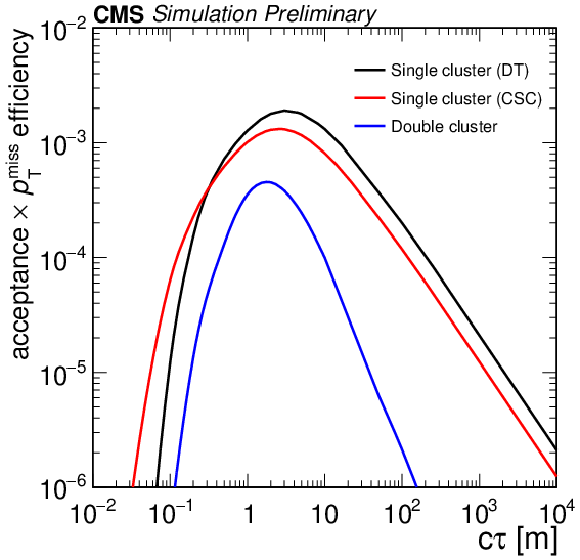
png pdf |
Figure 4:
The geometric acceptance and the efficiency of the $ p_{\mathrm{T}}^\text{miss} \geq $ 200 GeV selection as a function of S proper decay length for a mass of 40 GeV. |
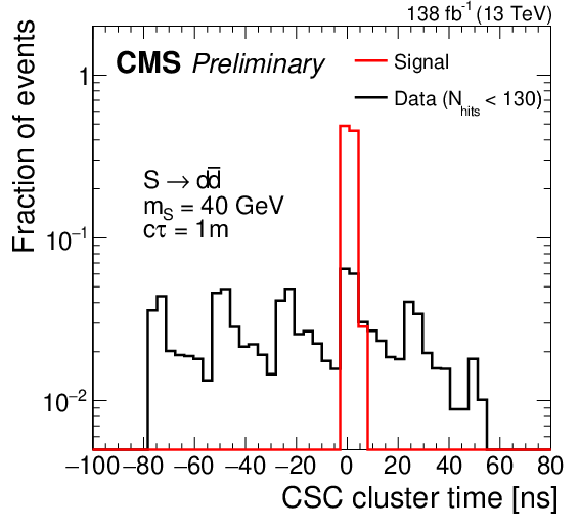
png pdf |
Figure 5:
Distributions of cluster time are shown for S decaying to $ \mathrm{d}\overline{\mathrm{d}} $ for a proper decay length of 1 m and mass of 40 GeV, and for a background-enriched sample in data selected by inverting the $ N_\text{hits} $ requirement. The distributions are normalized to unit area. |
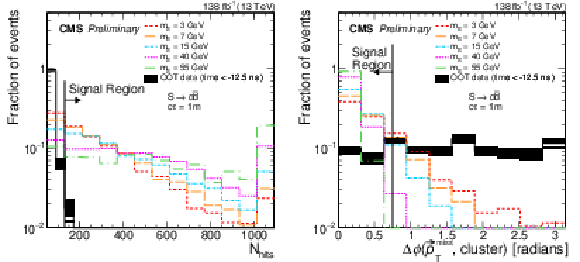
png pdf |
Figure 6:
Distributions of $ N_\text{hits} $ (left) and $ \Delta\phi{\mathrm{(}{\vec p}_{\mathrm{T}}^{\ \text{miss}}\mathrm{, cluster)}} $ (right) are shown for S decaying to $ \mathrm{d}\overline{\mathrm{d}} $ for a proper decay length of 1 m and various masses compared to the OOT background ($ t_\text{cluster} < - $ 12.5 ns). The distributions are normalized to unit area. The OOT background is representative of the overall background shape, because the background passing all the selections described above is dominated by pileup and underlying events. |
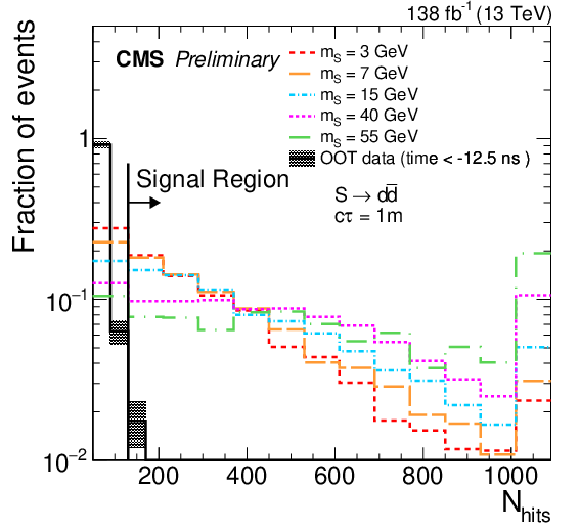
png pdf |
Figure 6-a:
Distributions of $ N_\text{hits} $ (left) and $ \Delta\phi{\mathrm{(}{\vec p}_{\mathrm{T}}^{\ \text{miss}}\mathrm{, cluster)}} $ (right) are shown for S decaying to $ \mathrm{d}\overline{\mathrm{d}} $ for a proper decay length of 1 m and various masses compared to the OOT background ($ t_\text{cluster} < - $ 12.5 ns). The distributions are normalized to unit area. The OOT background is representative of the overall background shape, because the background passing all the selections described above is dominated by pileup and underlying events. |
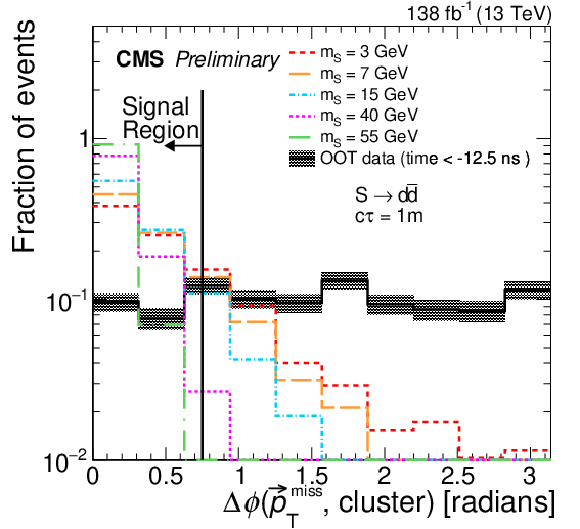
png pdf |
Figure 6-b:
Distributions of $ N_\text{hits} $ (left) and $ \Delta\phi{\mathrm{(}{\vec p}_{\mathrm{T}}^{\ \text{miss}}\mathrm{, cluster)}} $ (right) are shown for S decaying to $ \mathrm{d}\overline{\mathrm{d}} $ for a proper decay length of 1 m and various masses compared to the OOT background ($ t_\text{cluster} < - $ 12.5 ns). The distributions are normalized to unit area. The OOT background is representative of the overall background shape, because the background passing all the selections described above is dominated by pileup and underlying events. |

png pdf |
Figure 7:
Distributions of $ N_\text{hits} $ (left) and $ \Delta\phi{\mathrm{(}{\vec p}_{\mathrm{T}}^{\ \text{miss}}\mathrm{, cluster)}} $ (right) for DT clusters are shown for S decaying to $ \mathrm{d}\overline{\mathrm{d}} $ for a proper decay length of 1 m and various masses compared to the shape of background in a selection where the cluster is not matched to any RPC hit. The distributions are normalized to unit area. |
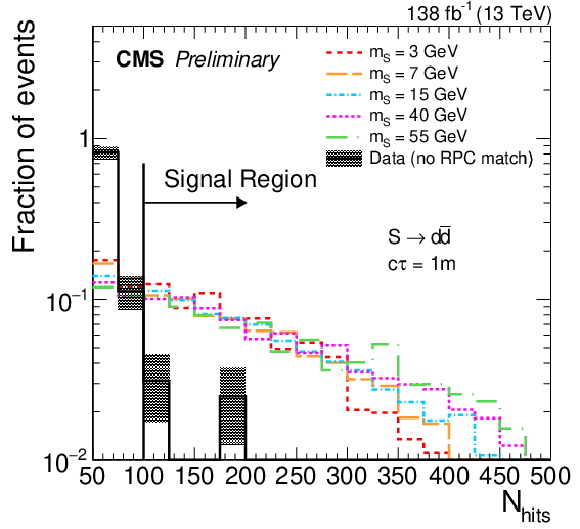
png pdf |
Figure 7-a:
Distributions of $ N_\text{hits} $ (left) and $ \Delta\phi{\mathrm{(}{\vec p}_{\mathrm{T}}^{\ \text{miss}}\mathrm{, cluster)}} $ (right) for DT clusters are shown for S decaying to $ \mathrm{d}\overline{\mathrm{d}} $ for a proper decay length of 1 m and various masses compared to the shape of background in a selection where the cluster is not matched to any RPC hit. The distributions are normalized to unit area. |

png pdf |
Figure 7-b:
Distributions of $ N_\text{hits} $ (left) and $ \Delta\phi{\mathrm{(}{\vec p}_{\mathrm{T}}^{\ \text{miss}}\mathrm{, cluster)}} $ (right) for DT clusters are shown for S decaying to $ \mathrm{d}\overline{\mathrm{d}} $ for a proper decay length of 1 m and various masses compared to the shape of background in a selection where the cluster is not matched to any RPC hit. The distributions are normalized to unit area. |

png pdf |
Figure 8:
Diagrams illustrating the ABCD plane for the DT-CSC category (left) and for the DT-DT and CSC-CSC categories (right). The variable $ c_1 $ is the pass-fail ratio of the $ N_\text{hits} $ selection for the background cluster. Bin A is the signal region for all categories. |
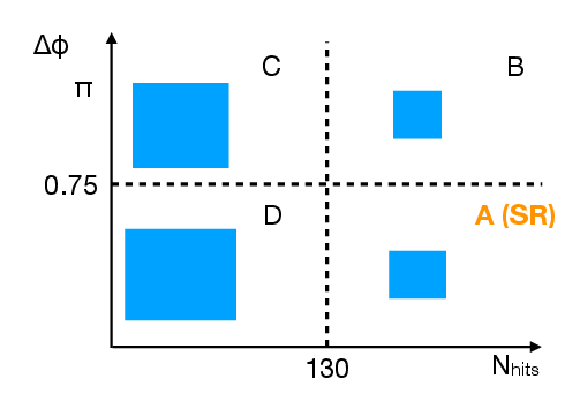
png pdf |
Figure 9:
Diagram illustrating the ABCD plane for the single CSC cluster category. Bin A is the signal region. |

png pdf |
Figure 10:
Distributions of $ N_\text{clusters} $ passing the $ N_\text{hits} $ selection in the search region for CSC-CSC (left), DT-DT (center), and DT-CSC (right) categories. The background predicted by the fit is shown in blue with the shaded region showing the fitted uncertainty. The expected signal with $ \mathcal{B}(\mathrm{H}\to\mathrm{S}\mathrm{S}) = $ 1%, $ \mathrm{S}\to\mathrm{d}\overline{\mathrm{d}} $, and $ c\tau= $ 1 m is shown for $ m_\mathrm{S} $ of 3, 7, 15, 40, and 55 GeV in various colors and dotted lines. |

png pdf |
Figure 10-a:
Distributions of $ N_\text{clusters} $ passing the $ N_\text{hits} $ selection in the search region for CSC-CSC (left), DT-DT (center), and DT-CSC (right) categories. The background predicted by the fit is shown in blue with the shaded region showing the fitted uncertainty. The expected signal with $ \mathcal{B}(\mathrm{H}\to\mathrm{S}\mathrm{S}) = $ 1%, $ \mathrm{S}\to\mathrm{d}\overline{\mathrm{d}} $, and $ c\tau= $ 1 m is shown for $ m_\mathrm{S} $ of 3, 7, 15, 40, and 55 GeV in various colors and dotted lines. |
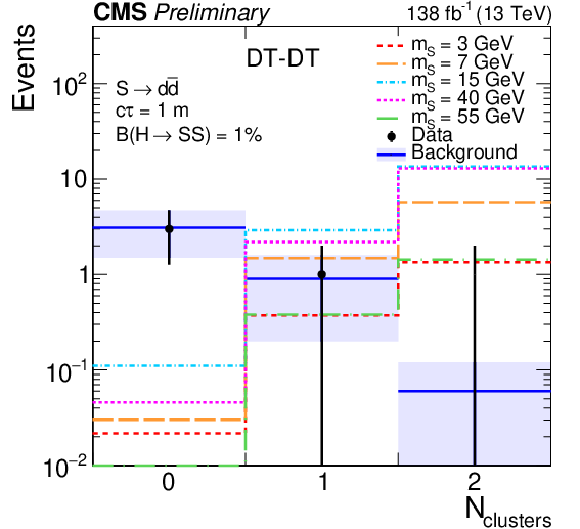
png pdf |
Figure 10-b:
Distributions of $ N_\text{clusters} $ passing the $ N_\text{hits} $ selection in the search region for CSC-CSC (left), DT-DT (center), and DT-CSC (right) categories. The background predicted by the fit is shown in blue with the shaded region showing the fitted uncertainty. The expected signal with $ \mathcal{B}(\mathrm{H}\to\mathrm{S}\mathrm{S}) = $ 1%, $ \mathrm{S}\to\mathrm{d}\overline{\mathrm{d}} $, and $ c\tau= $ 1 m is shown for $ m_\mathrm{S} $ of 3, 7, 15, 40, and 55 GeV in various colors and dotted lines. |
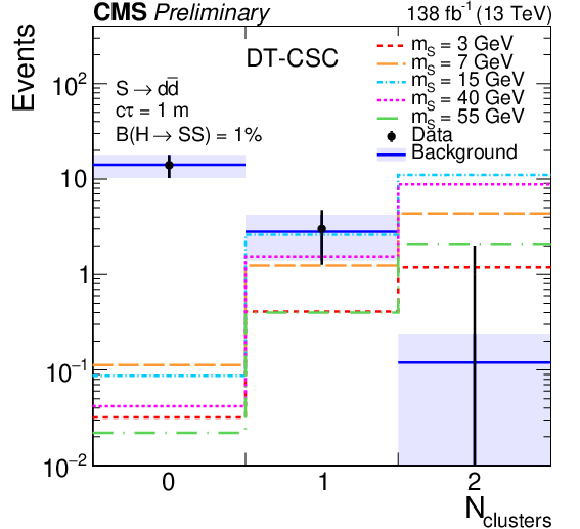
png pdf |
Figure 10-c:
Distributions of $ N_\text{clusters} $ passing the $ N_\text{hits} $ selection in the search region for CSC-CSC (left), DT-DT (center), and DT-CSC (right) categories. The background predicted by the fit is shown in blue with the shaded region showing the fitted uncertainty. The expected signal with $ \mathcal{B}(\mathrm{H}\to\mathrm{S}\mathrm{S}) = $ 1%, $ \mathrm{S}\to\mathrm{d}\overline{\mathrm{d}} $, and $ c\tau= $ 1 m is shown for $ m_\mathrm{S} $ of 3, 7, 15, 40, and 55 GeV in various colors and dotted lines. |

png pdf |
Figure 11:
Distributions of $ N_\text{hits} $ (left) and $ \Delta\phi{\mathrm{(}{\vec p}_{\mathrm{T}}^{\ \text{miss}}\mathrm{, cluster)}} $ (right) in the search region of the single CSC cluster category. The background predicted by the fit is shown in blue with the shaded region showing the fitted uncertainty. The expected signal with $ \mathcal{B}(\mathrm{H}\to\mathrm{S}\mathrm{S}) = $ 1%, $ \mathrm{S}\to\mathrm{d}\overline{\mathrm{d}} $, and $ c\tau= $ 1 m is shown for $ m_\mathrm{S} $ of 3, 7, 15, 40, and 55 GeV in various colors and dotted lines. The $ N_\text{hits} $ distribution includes only events in bins A and D, while the $ \Delta\phi{\mathrm{(}{\vec p}_{\mathrm{T}}^{\ \text{miss}}\mathrm{, cluster)}} $ one includes only events in bins A and B. The last bin in the $ N_\text{hits} $ distribution includes overflow events. |
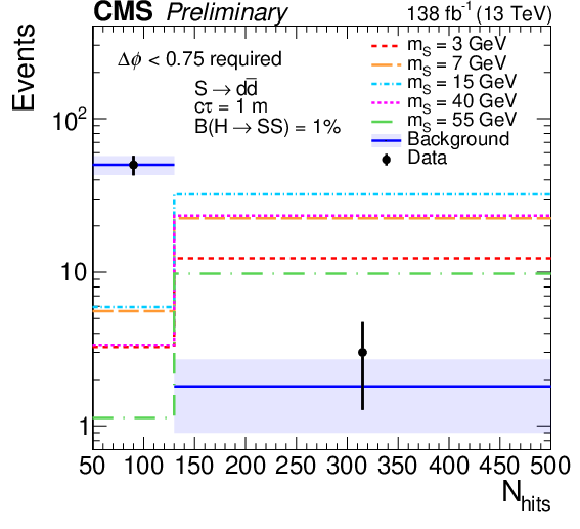
png pdf |
Figure 11-a:
Distributions of $ N_\text{hits} $ (left) and $ \Delta\phi{\mathrm{(}{\vec p}_{\mathrm{T}}^{\ \text{miss}}\mathrm{, cluster)}} $ (right) in the search region of the single CSC cluster category. The background predicted by the fit is shown in blue with the shaded region showing the fitted uncertainty. The expected signal with $ \mathcal{B}(\mathrm{H}\to\mathrm{S}\mathrm{S}) = $ 1%, $ \mathrm{S}\to\mathrm{d}\overline{\mathrm{d}} $, and $ c\tau= $ 1 m is shown for $ m_\mathrm{S} $ of 3, 7, 15, 40, and 55 GeV in various colors and dotted lines. The $ N_\text{hits} $ distribution includes only events in bins A and D, while the $ \Delta\phi{\mathrm{(}{\vec p}_{\mathrm{T}}^{\ \text{miss}}\mathrm{, cluster)}} $ one includes only events in bins A and B. The last bin in the $ N_\text{hits} $ distribution includes overflow events. |
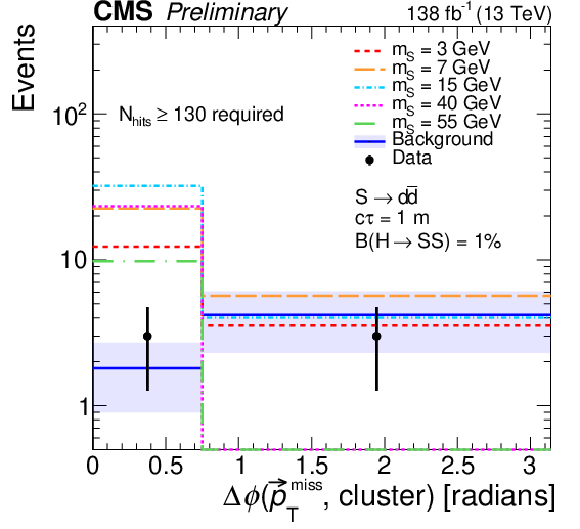
png pdf |
Figure 11-b:
Distributions of $ N_\text{hits} $ (left) and $ \Delta\phi{\mathrm{(}{\vec p}_{\mathrm{T}}^{\ \text{miss}}\mathrm{, cluster)}} $ (right) in the search region of the single CSC cluster category. The background predicted by the fit is shown in blue with the shaded region showing the fitted uncertainty. The expected signal with $ \mathcal{B}(\mathrm{H}\to\mathrm{S}\mathrm{S}) = $ 1%, $ \mathrm{S}\to\mathrm{d}\overline{\mathrm{d}} $, and $ c\tau= $ 1 m is shown for $ m_\mathrm{S} $ of 3, 7, 15, 40, and 55 GeV in various colors and dotted lines. The $ N_\text{hits} $ distribution includes only events in bins A and D, while the $ \Delta\phi{\mathrm{(}{\vec p}_{\mathrm{T}}^{\ \text{miss}}\mathrm{, cluster)}} $ one includes only events in bins A and B. The last bin in the $ N_\text{hits} $ distribution includes overflow events. |

png pdf |
Figure 12:
Distributions of $ N_\text{hits} $ (left) and $ \Delta\phi{\mathrm{(}{\vec p}_{\mathrm{T}}^{\ \text{miss}}\mathrm{, cluster)}} $ (right) in the search region of the single DT cluster category. The background predicted by the fit is shown in blue with the shaded region showing the fitted uncertainty. The expected signal with $ \mathcal{B}(\mathrm{H}\to\mathrm{S}\mathrm{S}) = $ 1%, $ \mathrm{S}\to\mathrm{d}\overline{\mathrm{d}} $, and $ c\tau= $ 1 m is shown for $ m_\mathrm{S} $ of 3, 7, 15, 40, and 55 GeV in various colors and dotted lines. The $ N_\text{hits} $ distribution includes only events in bins A and D, while the $ \Delta\phi{\mathrm{(}{\vec p}_{\mathrm{T}}^{\ \text{miss}}\mathrm{, cluster)}} $ one includes only events in bins A and B. The last bin in the $ N_\text{hits} $ distribution includes overflow events. |
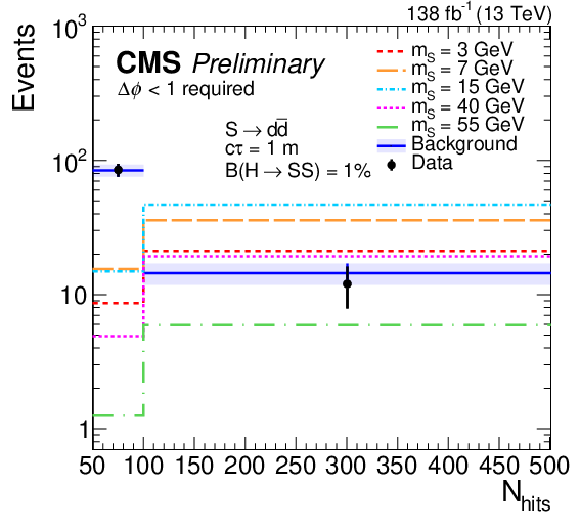
png pdf |
Figure 12-a:
Distributions of $ N_\text{hits} $ (left) and $ \Delta\phi{\mathrm{(}{\vec p}_{\mathrm{T}}^{\ \text{miss}}\mathrm{, cluster)}} $ (right) in the search region of the single DT cluster category. The background predicted by the fit is shown in blue with the shaded region showing the fitted uncertainty. The expected signal with $ \mathcal{B}(\mathrm{H}\to\mathrm{S}\mathrm{S}) = $ 1%, $ \mathrm{S}\to\mathrm{d}\overline{\mathrm{d}} $, and $ c\tau= $ 1 m is shown for $ m_\mathrm{S} $ of 3, 7, 15, 40, and 55 GeV in various colors and dotted lines. The $ N_\text{hits} $ distribution includes only events in bins A and D, while the $ \Delta\phi{\mathrm{(}{\vec p}_{\mathrm{T}}^{\ \text{miss}}\mathrm{, cluster)}} $ one includes only events in bins A and B. The last bin in the $ N_\text{hits} $ distribution includes overflow events. |

png pdf |
Figure 12-b:
Distributions of $ N_\text{hits} $ (left) and $ \Delta\phi{\mathrm{(}{\vec p}_{\mathrm{T}}^{\ \text{miss}}\mathrm{, cluster)}} $ (right) in the search region of the single DT cluster category. The background predicted by the fit is shown in blue with the shaded region showing the fitted uncertainty. The expected signal with $ \mathcal{B}(\mathrm{H}\to\mathrm{S}\mathrm{S}) = $ 1%, $ \mathrm{S}\to\mathrm{d}\overline{\mathrm{d}} $, and $ c\tau= $ 1 m is shown for $ m_\mathrm{S} $ of 3, 7, 15, 40, and 55 GeV in various colors and dotted lines. The $ N_\text{hits} $ distribution includes only events in bins A and D, while the $ \Delta\phi{\mathrm{(}{\vec p}_{\mathrm{T}}^{\ \text{miss}}\mathrm{, cluster)}} $ one includes only events in bins A and B. The last bin in the $ N_\text{hits} $ distribution includes overflow events. |

png pdf |
Figure 13:
The 95% CL expected (dotted curves) and observed (solid curves) upper limits on the branching fraction $ \mathcal{B}(\mathrm{H}\to\mathrm{S}\mathrm{S}) $ as a function of $ c\tau $ for the $ \mathrm{S}\to\mathrm{d}\overline{\mathrm{d}} $ (top left), $ \mathrm{S}\to\pi^{0}\pi^{0} $ (top right), and $ \mathrm{S}\to\tau^{+}\tau^{-} $ (bottom) decay modes. The exclusion limits are shown for different mass hypotheses: 0.4, 1, 3, 7, 15, 40, and 55 GeV. |
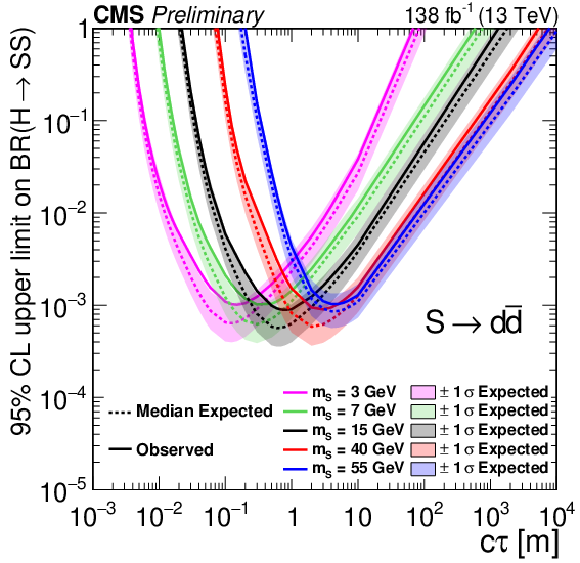
png pdf |
Figure 13-a:
The 95% CL expected (dotted curves) and observed (solid curves) upper limits on the branching fraction $ \mathcal{B}(\mathrm{H}\to\mathrm{S}\mathrm{S}) $ as a function of $ c\tau $ for the $ \mathrm{S}\to\mathrm{d}\overline{\mathrm{d}} $ (top left), $ \mathrm{S}\to\pi^{0}\pi^{0} $ (top right), and $ \mathrm{S}\to\tau^{+}\tau^{-} $ (bottom) decay modes. The exclusion limits are shown for different mass hypotheses: 0.4, 1, 3, 7, 15, 40, and 55 GeV. |

png pdf |
Figure 13-b:
The 95% CL expected (dotted curves) and observed (solid curves) upper limits on the branching fraction $ \mathcal{B}(\mathrm{H}\to\mathrm{S}\mathrm{S}) $ as a function of $ c\tau $ for the $ \mathrm{S}\to\mathrm{d}\overline{\mathrm{d}} $ (top left), $ \mathrm{S}\to\pi^{0}\pi^{0} $ (top right), and $ \mathrm{S}\to\tau^{+}\tau^{-} $ (bottom) decay modes. The exclusion limits are shown for different mass hypotheses: 0.4, 1, 3, 7, 15, 40, and 55 GeV. |

png pdf |
Figure 13-c:
The 95% CL expected (dotted curves) and observed (solid curves) upper limits on the branching fraction $ \mathcal{B}(\mathrm{H}\to\mathrm{S}\mathrm{S}) $ as a function of $ c\tau $ for the $ \mathrm{S}\to\mathrm{d}\overline{\mathrm{d}} $ (top left), $ \mathrm{S}\to\pi^{0}\pi^{0} $ (top right), and $ \mathrm{S}\to\tau^{+}\tau^{-} $ (bottom) decay modes. The exclusion limits are shown for different mass hypotheses: 0.4, 1, 3, 7, 15, 40, and 55 GeV. |
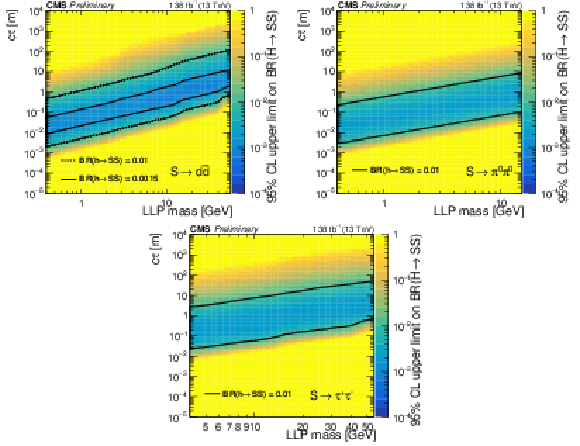
png pdf |
Figure 14:
The 95% CL observed upper limits on the branching fraction $ \mathcal{B}(\mathrm{H}\to\mathrm{S}\mathrm{S}) $ as a function of mass and $ c\tau $ for the $ \mathrm{S}\to\mathrm{d}\overline{\mathrm{d}} $ (top left), $ \mathrm{S}\to\pi^{0}\pi^{0} $ (top right), and $ \mathrm{S}\to\tau^{+}\tau^{-} $ (bottom) decay modes. |
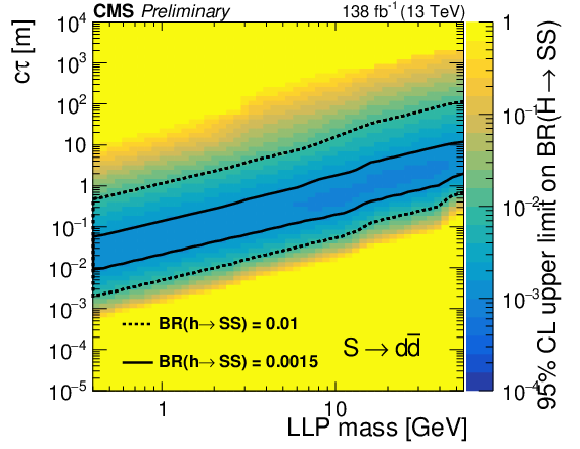
png pdf |
Figure 14-a:
The 95% CL observed upper limits on the branching fraction $ \mathcal{B}(\mathrm{H}\to\mathrm{S}\mathrm{S}) $ as a function of mass and $ c\tau $ for the $ \mathrm{S}\to\mathrm{d}\overline{\mathrm{d}} $ (top left), $ \mathrm{S}\to\pi^{0}\pi^{0} $ (top right), and $ \mathrm{S}\to\tau^{+}\tau^{-} $ (bottom) decay modes. |
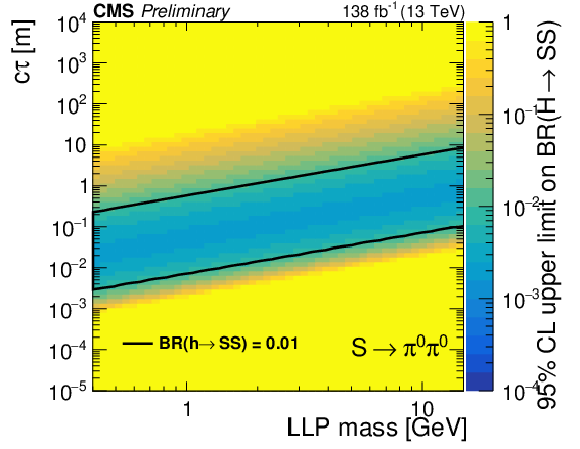
png pdf |
Figure 14-b:
The 95% CL observed upper limits on the branching fraction $ \mathcal{B}(\mathrm{H}\to\mathrm{S}\mathrm{S}) $ as a function of mass and $ c\tau $ for the $ \mathrm{S}\to\mathrm{d}\overline{\mathrm{d}} $ (top left), $ \mathrm{S}\to\pi^{0}\pi^{0} $ (top right), and $ \mathrm{S}\to\tau^{+}\tau^{-} $ (bottom) decay modes. |
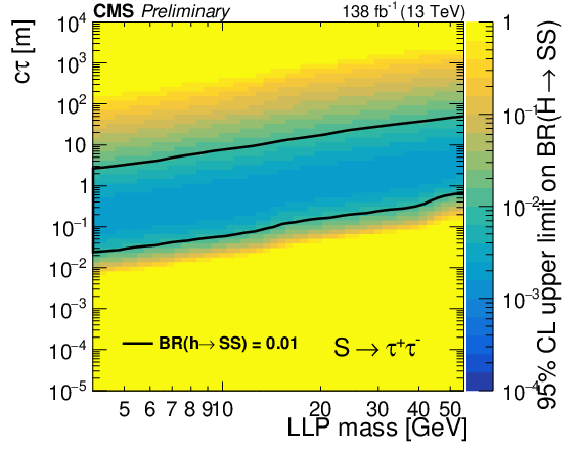
png pdf |
Figure 14-c:
The 95% CL observed upper limits on the branching fraction $ \mathcal{B}(\mathrm{H}\to\mathrm{S}\mathrm{S}) $ as a function of mass and $ c\tau $ for the $ \mathrm{S}\to\mathrm{d}\overline{\mathrm{d}} $ (top left), $ \mathrm{S}\to\pi^{0}\pi^{0} $ (top right), and $ \mathrm{S}\to\tau^{+}\tau^{-} $ (bottom) decay modes. |

png pdf |
Figure 15:
The 95% CL observed upper limits on the branching fraction $ \mathcal{B}(\mathrm{H}\to\mathrm{S}\mathrm{S}) $ as a function of mass and $ c\tau $, assuming the branching fractions for S calculated in Ref. [67]. |
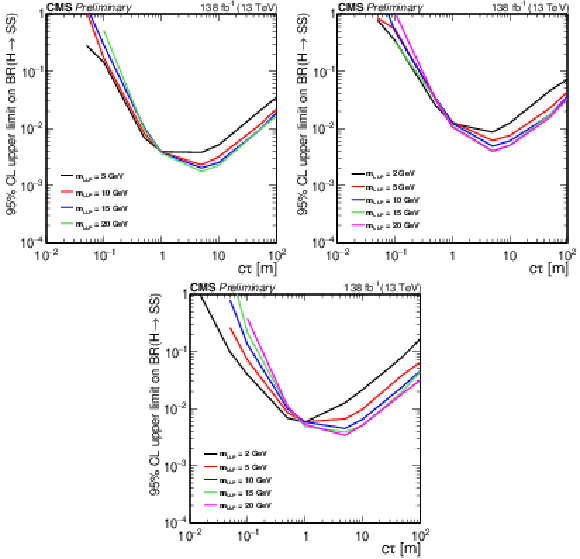
png pdf |
Figure 16:
The 95% CL observed upper limits on the branching fraction $ \mathcal{B}(\mathrm{h}^0\to\Psi\Psi) $ as functions of $ c\tau $ for the gluon portal (top left) assuming $ (x_{i\omega} $, $ x_{i\Lambda}) = $ (2.5, 1), photon portal (top right) assuming $ (x_{i\omega} $, $ x_{i\Lambda}) = $ (2.5, 1), and vector portal (bottom) assuming $ (x_{i\omega} $, $ x_{i\Lambda}) = $ (1, 1). The exclusion limits are shown for different LLP mass hypotheses: 2, 5, 10, 15, and 20 GeV. |

png pdf |
Figure 16-a:
The 95% CL observed upper limits on the branching fraction $ \mathcal{B}(\mathrm{h}^0\to\Psi\Psi) $ as functions of $ c\tau $ for the gluon portal (top left) assuming $ (x_{i\omega} $, $ x_{i\Lambda}) = $ (2.5, 1), photon portal (top right) assuming $ (x_{i\omega} $, $ x_{i\Lambda}) = $ (2.5, 1), and vector portal (bottom) assuming $ (x_{i\omega} $, $ x_{i\Lambda}) = $ (1, 1). The exclusion limits are shown for different LLP mass hypotheses: 2, 5, 10, 15, and 20 GeV. |
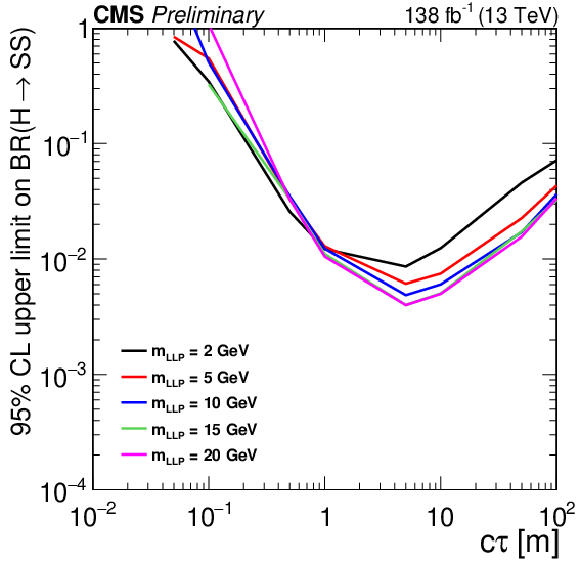
png pdf |
Figure 16-b:
The 95% CL observed upper limits on the branching fraction $ \mathcal{B}(\mathrm{h}^0\to\Psi\Psi) $ as functions of $ c\tau $ for the gluon portal (top left) assuming $ (x_{i\omega} $, $ x_{i\Lambda}) = $ (2.5, 1), photon portal (top right) assuming $ (x_{i\omega} $, $ x_{i\Lambda}) = $ (2.5, 1), and vector portal (bottom) assuming $ (x_{i\omega} $, $ x_{i\Lambda}) = $ (1, 1). The exclusion limits are shown for different LLP mass hypotheses: 2, 5, 10, 15, and 20 GeV. |

png pdf |
Figure 16-c:
The 95% CL observed upper limits on the branching fraction $ \mathcal{B}(\mathrm{h}^0\to\Psi\Psi) $ as functions of $ c\tau $ for the gluon portal (top left) assuming $ (x_{i\omega} $, $ x_{i\Lambda}) = $ (2.5, 1), photon portal (top right) assuming $ (x_{i\omega} $, $ x_{i\Lambda}) = $ (2.5, 1), and vector portal (bottom) assuming $ (x_{i\omega} $, $ x_{i\Lambda}) = $ (1, 1). The exclusion limits are shown for different LLP mass hypotheses: 2, 5, 10, 15, and 20 GeV. |
| Tables | |

png pdf |
Table 1:
Comparison between the ABCD predicted and observed yields in both validation regions for the double cluster category. The uncertainty of the prediction is the statistical uncertainty propagated from bins B, C, and D or bins BD and C. The symbol $ \lambda_\mathrm{X} $ is the expected background event rate in bin X, while $ N_\mathrm{X} $ is the observed number of events in bin X. |

png pdf |
Table 2:
Comparison between the ABCD predicted and observed yields in the validation regions for the single CSC cluster category. The uncertainty of the prediction is the statistical uncertainty propagated from bins B, C, and D. The symbol $ \lambda_\mathrm{X} $ is the expected background event rate in bin X, while $ N_\mathrm{X} $ is the observed number of events in bin X. |

png pdf |
Table 3:
Comparison between the ABCD predicted and observed yields in a pileup-enriched region for the single DT cluster category. The uncertainty of the prediction is the statistical uncertainty propagated from bins B, C, and D. Bins C and D for MB3 and MB4 categories are combined to reduce statistical uncertainty in the two regions. The final ABCD fit in the signal region will also be performed with those bins combined. |

png pdf |
Table 4:
Validation of the punch-through jet background prediction method for the single DT cluster category. The uncertainty of the prediction is the statistical uncertainty propagated from the extrapolated MB1/MB2 hit veto efficiency. |

png pdf |
Table 5:
Number of predicted background and observed events in the double cluster category. |

png pdf |
Table 6:
Number of predicted background and observed events in the single CSC cluster category. |

png pdf |
Table 7:
Number of predicted background and observed events in the single DT cluster category. |

png pdf |
Table 8:
Number of signal events in bin A for each category for a few benchmark signal models assuming $ \mathcal{B}(\mathrm{H}\to\mathrm{S}\mathrm{S}) = $ 1%. |
| Summary |
| In summary, proton-proton collision data at $ \sqrt{s} = $ 13 TeV recorded by the CMS experiment in 2016--2018, corresponding to an integrated luminosity of 138 fb$ ^{-1} $, have been used to conduct the first search that uses both the barrel and endcap CMS muon detectors to detect hadronic and electromagnetic showers from long-lived particle (LLP) decays. Based on the unique detector signature, the search is largely model-independent, with sensitivity to a broad range of LLP decay modes and masses below the GeV scale. With the excellent shielding provided by the inner CMS detector, the CMS magnet, and the steel return yoke, the background is suppressed to a low level and a search for both single and double LLP decays is possible. No significant deviation from the standard model background is observed. The most stringent LHC constraints to date are set on the branching fraction of the Higgs boson to LLPs with masses below 10 GeV and decaying to particles other than muons. The search provides the most stringent branching fraction limit for proper decay lengths in the range 0.04-0.4 m and above 4 m for an LLP mass of 15 GeV, in the range 0.3-0.9 m and above 3 m for an LLP mass of 40 GeV, and above 0.8 m for an LLP mass of 55 GeV. Finally, the first LHC limits on models of dark showers produced via Higgs boson decay are set, and constrain branching fractions of the Higgs boson decay to dark quarks as low as 10$^{-3} $. |
| Additional Figures | |
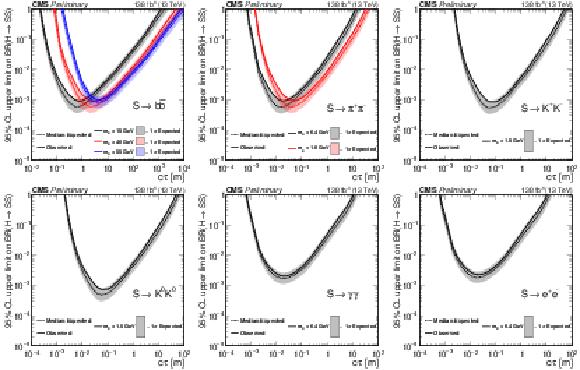
png pdf |
Additional Figure 1:
The 95% CL expected (dotted curves) and observed (solid curves) upper limits on the branching fraction $ \mathcal{B}(\mathrm{H}\to\mathrm{S}\mathrm{S}) $ as functions of $ c\tau $ for the $ \mathrm{S}\to\mathrm{b}\overline{\mathrm{b}} $ (top left), $ \mathrm{S}\to\pi^{+}\pi^{-} $ (top center), and $ \mathrm{S}\to \mathrm{K^+}\mathrm{K^-} $ (top right), $ \mathrm{S}\to \mathrm{K^0}\mathrm{K^0} $ (bottom left), $ \mathrm{S}\to \gamma\gamma $ (bottom center), $ \mathrm{S}\to \mathrm{e}^+\mathrm{e}^- $ (bottom right) decay modes. The exclusion limits are shown for different mass hypotheses: 0.4, 1, 1.5, 3, 15, 40, and 55 GeV. |
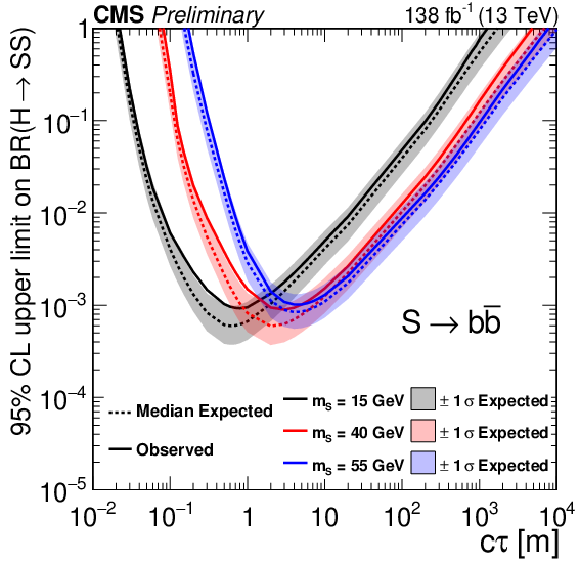
png pdf |
Additional Figure 1-a:
The 95% CL expected (dotted curves) and observed (solid curves) upper limits on the branching fraction $ \mathcal{B}(\mathrm{H}\to\mathrm{S}\mathrm{S}) $ as functions of $ c\tau $ for the $ \mathrm{S}\to\mathrm{b}\overline{\mathrm{b}} $ (top left), $ \mathrm{S}\to\pi^{+}\pi^{-} $ (top center), and $ \mathrm{S}\to \mathrm{K^+}\mathrm{K^-} $ (top right), $ \mathrm{S}\to \mathrm{K^0}\mathrm{K^0} $ (bottom left), $ \mathrm{S}\to \gamma\gamma $ (bottom center), $ \mathrm{S}\to \mathrm{e}^+\mathrm{e}^- $ (bottom right) decay modes. The exclusion limits are shown for different mass hypotheses: 0.4, 1, 1.5, 3, 15, 40, and 55 GeV. |

png pdf |
Additional Figure 1-b:
The 95% CL expected (dotted curves) and observed (solid curves) upper limits on the branching fraction $ \mathcal{B}(\mathrm{H}\to\mathrm{S}\mathrm{S}) $ as functions of $ c\tau $ for the $ \mathrm{S}\to\mathrm{b}\overline{\mathrm{b}} $ (top left), $ \mathrm{S}\to\pi^{+}\pi^{-} $ (top center), and $ \mathrm{S}\to \mathrm{K^+}\mathrm{K^-} $ (top right), $ \mathrm{S}\to \mathrm{K^0}\mathrm{K^0} $ (bottom left), $ \mathrm{S}\to \gamma\gamma $ (bottom center), $ \mathrm{S}\to \mathrm{e}^+\mathrm{e}^- $ (bottom right) decay modes. The exclusion limits are shown for different mass hypotheses: 0.4, 1, 1.5, 3, 15, 40, and 55 GeV. |
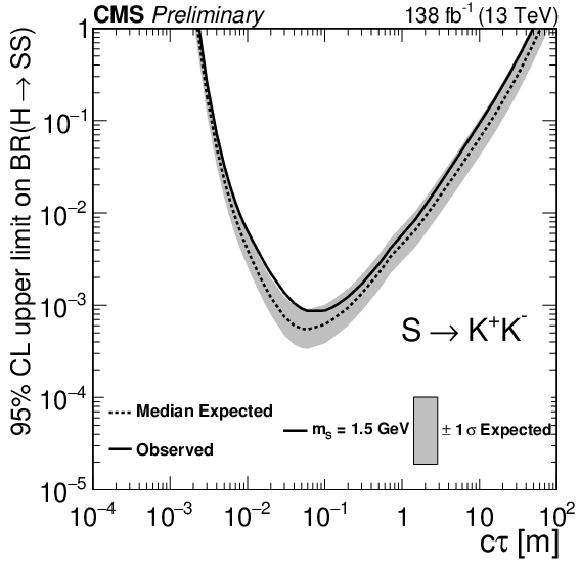
png pdf |
Additional Figure 1-c:
The 95% CL expected (dotted curves) and observed (solid curves) upper limits on the branching fraction $ \mathcal{B}(\mathrm{H}\to\mathrm{S}\mathrm{S}) $ as functions of $ c\tau $ for the $ \mathrm{S}\to\mathrm{b}\overline{\mathrm{b}} $ (top left), $ \mathrm{S}\to\pi^{+}\pi^{-} $ (top center), and $ \mathrm{S}\to \mathrm{K^+}\mathrm{K^-} $ (top right), $ \mathrm{S}\to \mathrm{K^0}\mathrm{K^0} $ (bottom left), $ \mathrm{S}\to \gamma\gamma $ (bottom center), $ \mathrm{S}\to \mathrm{e}^+\mathrm{e}^- $ (bottom right) decay modes. The exclusion limits are shown for different mass hypotheses: 0.4, 1, 1.5, 3, 15, 40, and 55 GeV. |
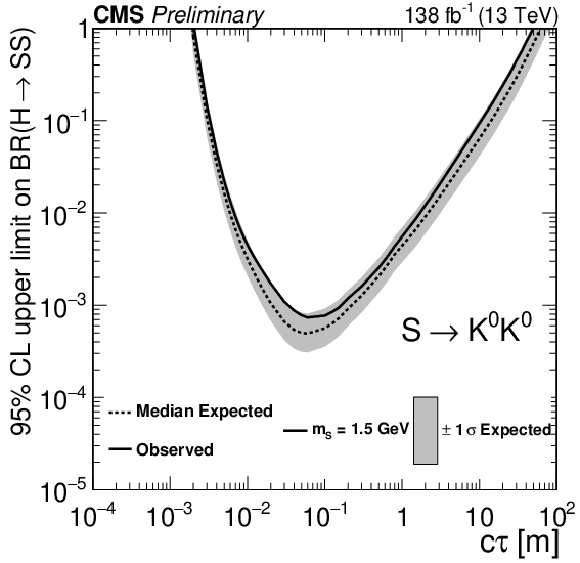
png pdf |
Additional Figure 1-d:
The 95% CL expected (dotted curves) and observed (solid curves) upper limits on the branching fraction $ \mathcal{B}(\mathrm{H}\to\mathrm{S}\mathrm{S}) $ as functions of $ c\tau $ for the $ \mathrm{S}\to\mathrm{b}\overline{\mathrm{b}} $ (top left), $ \mathrm{S}\to\pi^{+}\pi^{-} $ (top center), and $ \mathrm{S}\to \mathrm{K^+}\mathrm{K^-} $ (top right), $ \mathrm{S}\to \mathrm{K^0}\mathrm{K^0} $ (bottom left), $ \mathrm{S}\to \gamma\gamma $ (bottom center), $ \mathrm{S}\to \mathrm{e}^+\mathrm{e}^- $ (bottom right) decay modes. The exclusion limits are shown for different mass hypotheses: 0.4, 1, 1.5, 3, 15, 40, and 55 GeV. |

png pdf |
Additional Figure 1-e:
The 95% CL expected (dotted curves) and observed (solid curves) upper limits on the branching fraction $ \mathcal{B}(\mathrm{H}\to\mathrm{S}\mathrm{S}) $ as functions of $ c\tau $ for the $ \mathrm{S}\to\mathrm{b}\overline{\mathrm{b}} $ (top left), $ \mathrm{S}\to\pi^{+}\pi^{-} $ (top center), and $ \mathrm{S}\to \mathrm{K^+}\mathrm{K^-} $ (top right), $ \mathrm{S}\to \mathrm{K^0}\mathrm{K^0} $ (bottom left), $ \mathrm{S}\to \gamma\gamma $ (bottom center), $ \mathrm{S}\to \mathrm{e}^+\mathrm{e}^- $ (bottom right) decay modes. The exclusion limits are shown for different mass hypotheses: 0.4, 1, 1.5, 3, 15, 40, and 55 GeV. |
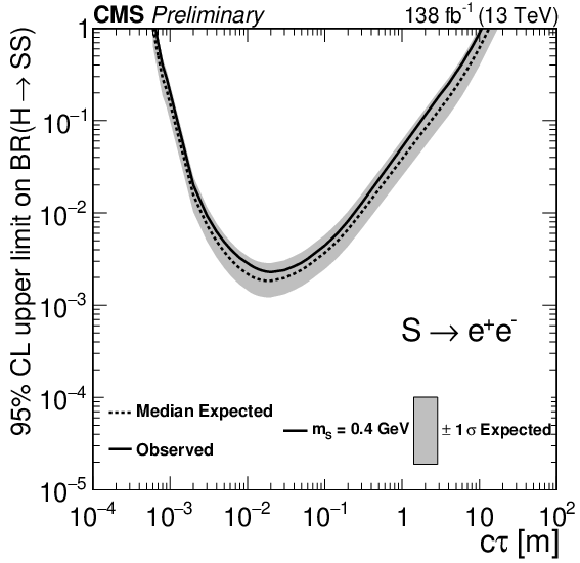
png pdf |
Additional Figure 1-f:
The 95% CL expected (dotted curves) and observed (solid curves) upper limits on the branching fraction $ \mathcal{B}(\mathrm{H}\to\mathrm{S}\mathrm{S}) $ as functions of $ c\tau $ for the $ \mathrm{S}\to\mathrm{b}\overline{\mathrm{b}} $ (top left), $ \mathrm{S}\to\pi^{+}\pi^{-} $ (top center), and $ \mathrm{S}\to \mathrm{K^+}\mathrm{K^-} $ (top right), $ \mathrm{S}\to \mathrm{K^0}\mathrm{K^0} $ (bottom left), $ \mathrm{S}\to \gamma\gamma $ (bottom center), $ \mathrm{S}\to \mathrm{e}^+\mathrm{e}^- $ (bottom right) decay modes. The exclusion limits are shown for different mass hypotheses: 0.4, 1, 1.5, 3, 15, 40, and 55 GeV. |
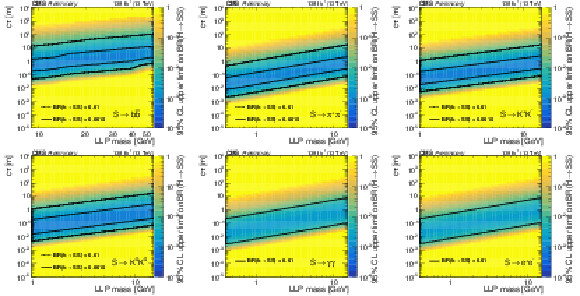
png pdf |
Additional Figure 2:
The 95% CL observed upper limits on the branching fraction $ \mathcal{B}(\mathrm{H}\to\mathrm{S}\mathrm{S}) $ as a function of mass and $ c\tau $ for the $ \mathrm{S}\to\mathrm{b}\overline{\mathrm{b}} $ (top left), $ \mathrm{S}\to\pi^{+}\pi^{-} $ (top center), and $ \mathrm{S}\to \mathrm{K^+}\mathrm{K^-} $ (top right), $ \mathrm{S}\to \mathrm{K^0}\mathrm{K^0} $ (bottom left), $ \mathrm{S}\to\gamma\gamma $ (bottom center), $ \mathrm{S}\to \mathrm{e}^+\mathrm{e}^- $ (bottom right) decay modes. |
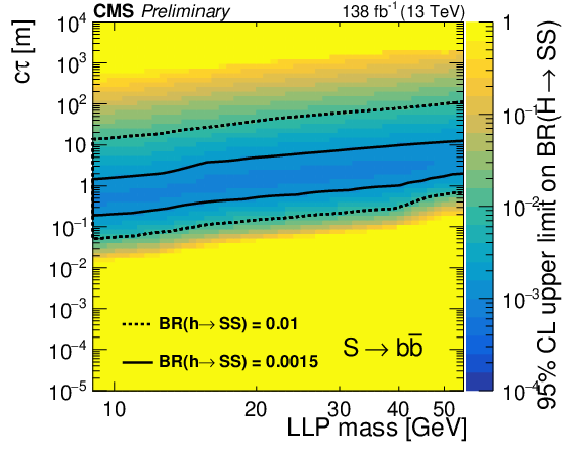
png pdf |
Additional Figure 2-a:
The 95% CL observed upper limits on the branching fraction $ \mathcal{B}(\mathrm{H}\to\mathrm{S}\mathrm{S}) $ as a function of mass and $ c\tau $ for the $ \mathrm{S}\to\mathrm{b}\overline{\mathrm{b}} $ (top left), $ \mathrm{S}\to\pi^{+}\pi^{-} $ (top center), and $ \mathrm{S}\to \mathrm{K^+}\mathrm{K^-} $ (top right), $ \mathrm{S}\to \mathrm{K^0}\mathrm{K^0} $ (bottom left), $ \mathrm{S}\to\gamma\gamma $ (bottom center), $ \mathrm{S}\to \mathrm{e}^+\mathrm{e}^- $ (bottom right) decay modes. |
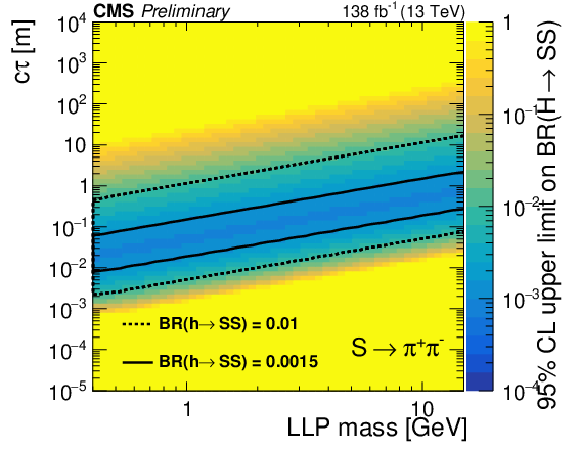
png pdf |
Additional Figure 2-b:
The 95% CL observed upper limits on the branching fraction $ \mathcal{B}(\mathrm{H}\to\mathrm{S}\mathrm{S}) $ as a function of mass and $ c\tau $ for the $ \mathrm{S}\to\mathrm{b}\overline{\mathrm{b}} $ (top left), $ \mathrm{S}\to\pi^{+}\pi^{-} $ (top center), and $ \mathrm{S}\to \mathrm{K^+}\mathrm{K^-} $ (top right), $ \mathrm{S}\to \mathrm{K^0}\mathrm{K^0} $ (bottom left), $ \mathrm{S}\to\gamma\gamma $ (bottom center), $ \mathrm{S}\to \mathrm{e}^+\mathrm{e}^- $ (bottom right) decay modes. |
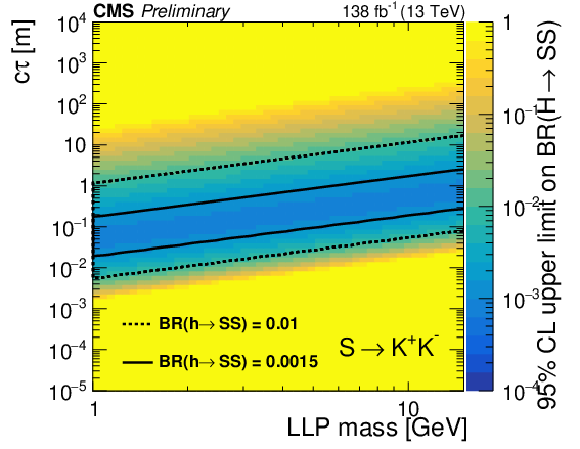
png pdf |
Additional Figure 2-c:
The 95% CL observed upper limits on the branching fraction $ \mathcal{B}(\mathrm{H}\to\mathrm{S}\mathrm{S}) $ as a function of mass and $ c\tau $ for the $ \mathrm{S}\to\mathrm{b}\overline{\mathrm{b}} $ (top left), $ \mathrm{S}\to\pi^{+}\pi^{-} $ (top center), and $ \mathrm{S}\to \mathrm{K^+}\mathrm{K^-} $ (top right), $ \mathrm{S}\to \mathrm{K^0}\mathrm{K^0} $ (bottom left), $ \mathrm{S}\to\gamma\gamma $ (bottom center), $ \mathrm{S}\to \mathrm{e}^+\mathrm{e}^- $ (bottom right) decay modes. |
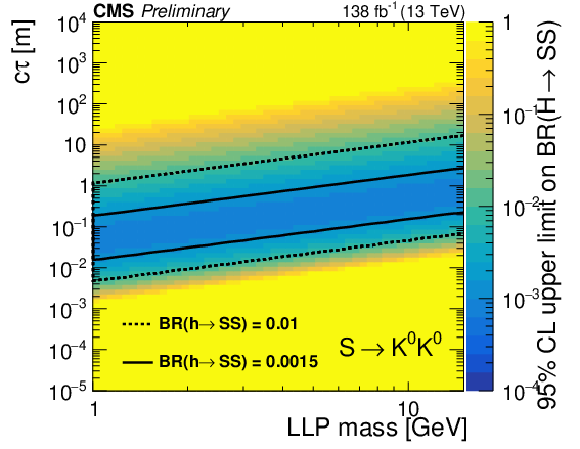
png pdf |
Additional Figure 2-d:
The 95% CL observed upper limits on the branching fraction $ \mathcal{B}(\mathrm{H}\to\mathrm{S}\mathrm{S}) $ as a function of mass and $ c\tau $ for the $ \mathrm{S}\to\mathrm{b}\overline{\mathrm{b}} $ (top left), $ \mathrm{S}\to\pi^{+}\pi^{-} $ (top center), and $ \mathrm{S}\to \mathrm{K^+}\mathrm{K^-} $ (top right), $ \mathrm{S}\to \mathrm{K^0}\mathrm{K^0} $ (bottom left), $ \mathrm{S}\to\gamma\gamma $ (bottom center), $ \mathrm{S}\to \mathrm{e}^+\mathrm{e}^- $ (bottom right) decay modes. |
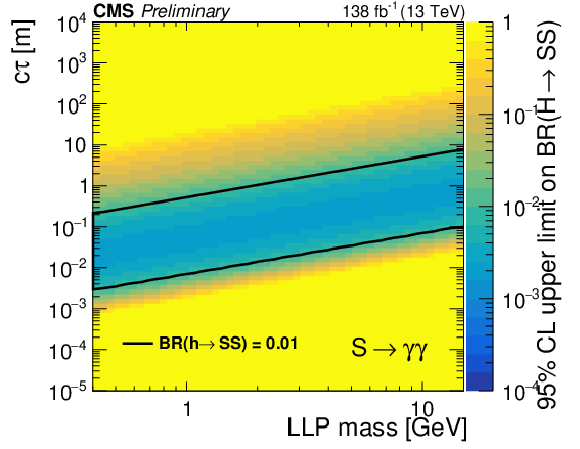
png pdf |
Additional Figure 2-e:
The 95% CL observed upper limits on the branching fraction $ \mathcal{B}(\mathrm{H}\to\mathrm{S}\mathrm{S}) $ as a function of mass and $ c\tau $ for the $ \mathrm{S}\to\mathrm{b}\overline{\mathrm{b}} $ (top left), $ \mathrm{S}\to\pi^{+}\pi^{-} $ (top center), and $ \mathrm{S}\to \mathrm{K^+}\mathrm{K^-} $ (top right), $ \mathrm{S}\to \mathrm{K^0}\mathrm{K^0} $ (bottom left), $ \mathrm{S}\to\gamma\gamma $ (bottom center), $ \mathrm{S}\to \mathrm{e}^+\mathrm{e}^- $ (bottom right) decay modes. |
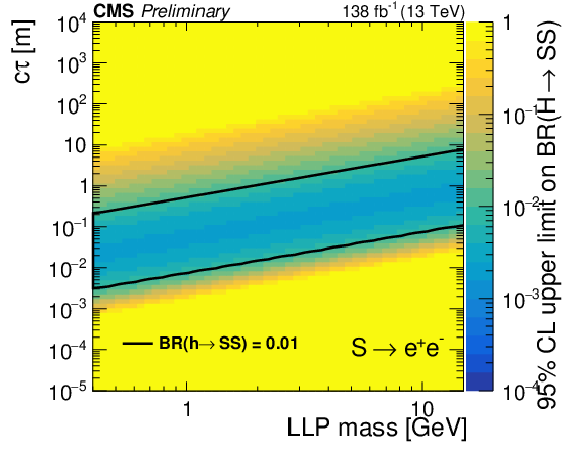
png pdf |
Additional Figure 2-f:
The 95% CL observed upper limits on the branching fraction $ \mathcal{B}(\mathrm{H}\to\mathrm{S}\mathrm{S}) $ as a function of mass and $ c\tau $ for the $ \mathrm{S}\to\mathrm{b}\overline{\mathrm{b}} $ (top left), $ \mathrm{S}\to\pi^{+}\pi^{-} $ (top center), and $ \mathrm{S}\to \mathrm{K^+}\mathrm{K^-} $ (top right), $ \mathrm{S}\to \mathrm{K^0}\mathrm{K^0} $ (bottom left), $ \mathrm{S}\to\gamma\gamma $ (bottom center), $ \mathrm{S}\to \mathrm{e}^+\mathrm{e}^- $ (bottom right) decay modes. |

png pdf |
Additional Figure 3:
The 95% CL observed upper limits on the branching fraction $ \mathcal{B}(\mathrm{h}^0\to\Psi\Psi) $ as functions of $ c\tau $ for the gluon portal, assuming $ x_{i\omega} = x_{i\Lambda} = $ 1.0 (left), $ x_{i\omega} = 2.5, x_{i\Lambda} = $ 1.0 (center), and $ x_{i\omega} = x_{i\Lambda} = $ 2.5 (right). The exclusion limits are shown for different mass hypotheses: 5, 10, 15, and 20 GeV. The center panel is shown again in the appendix, for completeness. |
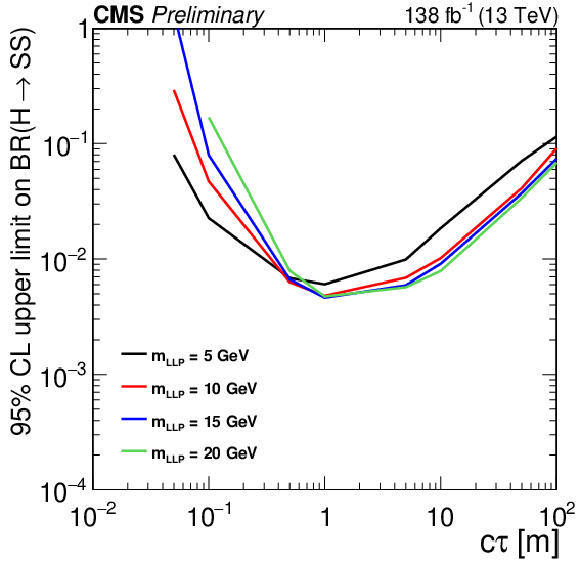
png pdf |
Additional Figure 3-a:
The 95% CL observed upper limits on the branching fraction $ \mathcal{B}(\mathrm{h}^0\to\Psi\Psi) $ as functions of $ c\tau $ for the gluon portal, assuming $ x_{i\omega} = x_{i\Lambda} = $ 1.0 (left), $ x_{i\omega} = 2.5, x_{i\Lambda} = $ 1.0 (center), and $ x_{i\omega} = x_{i\Lambda} = $ 2.5 (right). The exclusion limits are shown for different mass hypotheses: 5, 10, 15, and 20 GeV. The center panel is shown again in the appendix, for completeness. |

png pdf |
Additional Figure 3-b:
The 95% CL observed upper limits on the branching fraction $ \mathcal{B}(\mathrm{h}^0\to\Psi\Psi) $ as functions of $ c\tau $ for the gluon portal, assuming $ x_{i\omega} = x_{i\Lambda} = $ 1.0 (left), $ x_{i\omega} = 2.5, x_{i\Lambda} = $ 1.0 (center), and $ x_{i\omega} = x_{i\Lambda} = $ 2.5 (right). The exclusion limits are shown for different mass hypotheses: 5, 10, 15, and 20 GeV. The center panel is shown again in the appendix, for completeness. |

png pdf |
Additional Figure 3-c:
The 95% CL observed upper limits on the branching fraction $ \mathcal{B}(\mathrm{h}^0\to\Psi\Psi) $ as functions of $ c\tau $ for the gluon portal, assuming $ x_{i\omega} = x_{i\Lambda} = $ 1.0 (left), $ x_{i\omega} = 2.5, x_{i\Lambda} = $ 1.0 (center), and $ x_{i\omega} = x_{i\Lambda} = $ 2.5 (right). The exclusion limits are shown for different mass hypotheses: 5, 10, 15, and 20 GeV. The center panel is shown again in the appendix, for completeness. |

png pdf |
Additional Figure 4:
The 95% CL observed upper limits on the branching fraction $ \mathcal{B}(\mathrm{h}^0\to\Psi\Psi) $ as functions of $ c\tau $ for the photon portal, assuming $ x_{i\omega} = x_{i\Lambda} = $ 1.0 (left), $ x_{i\omega} = 2.5, x_{i\Lambda} = $ 1.0 (center), and $ x_{i\omega} = x_{i\Lambda} = $ 2.5 (right). The exclusion limits are shown for different mass hypotheses: 2, 5, 10, 15, and 20 GeV. The center limit plot is shown again in the appendix, for completeness. |

png pdf |
Additional Figure 4-a:
The 95% CL observed upper limits on the branching fraction $ \mathcal{B}(\mathrm{h}^0\to\Psi\Psi) $ as functions of $ c\tau $ for the photon portal, assuming $ x_{i\omega} = x_{i\Lambda} = $ 1.0 (left), $ x_{i\omega} = 2.5, x_{i\Lambda} = $ 1.0 (center), and $ x_{i\omega} = x_{i\Lambda} = $ 2.5 (right). The exclusion limits are shown for different mass hypotheses: 2, 5, 10, 15, and 20 GeV. The center limit plot is shown again in the appendix, for completeness. |
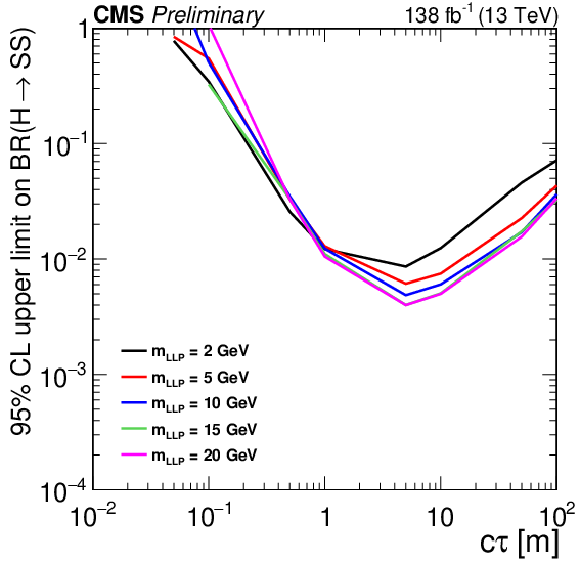
png pdf |
Additional Figure 4-b:
The 95% CL observed upper limits on the branching fraction $ \mathcal{B}(\mathrm{h}^0\to\Psi\Psi) $ as functions of $ c\tau $ for the photon portal, assuming $ x_{i\omega} = x_{i\Lambda} = $ 1.0 (left), $ x_{i\omega} = 2.5, x_{i\Lambda} = $ 1.0 (center), and $ x_{i\omega} = x_{i\Lambda} = $ 2.5 (right). The exclusion limits are shown for different mass hypotheses: 2, 5, 10, 15, and 20 GeV. The center limit plot is shown again in the appendix, for completeness. |
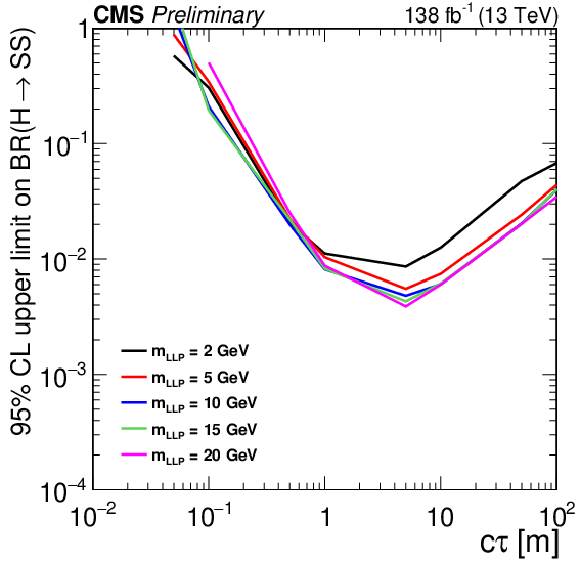
png pdf |
Additional Figure 4-c:
The 95% CL observed upper limits on the branching fraction $ \mathcal{B}(\mathrm{h}^0\to\Psi\Psi) $ as functions of $ c\tau $ for the photon portal, assuming $ x_{i\omega} = x_{i\Lambda} = $ 1.0 (left), $ x_{i\omega} = 2.5, x_{i\Lambda} = $ 1.0 (center), and $ x_{i\omega} = x_{i\Lambda} = $ 2.5 (right). The exclusion limits are shown for different mass hypotheses: 2, 5, 10, 15, and 20 GeV. The center limit plot is shown again in the appendix, for completeness. |

png pdf |
Additional Figure 5:
The 95% CL observed upper limits on the branching fraction $ \mathcal{B}(\mathrm{h}^0\to\Psi\Psi) $ as functions of $ c\tau $ for the Higgs portal, assuming $ x_{i\omega} = x_{i\Lambda} = $ 1.0 (left), $ x_{i\omega} = 2.5, x_{i\Lambda} = $ 1.0 (center), and $ x_{i\omega} = x_{i\Lambda} = $ 2.5 (right). The exclusion limits are shown for different mass hypotheses: 4, 5, 10, 15, and 20 GeV. |
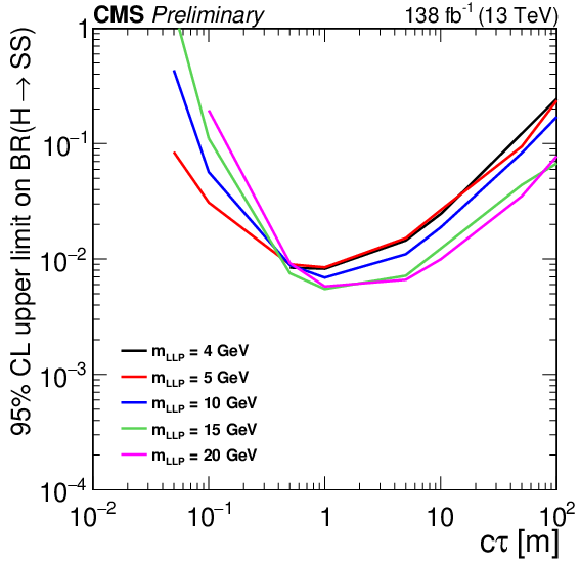
png pdf |
Additional Figure 5-a:
The 95% CL observed upper limits on the branching fraction $ \mathcal{B}(\mathrm{h}^0\to\Psi\Psi) $ as functions of $ c\tau $ for the Higgs portal, assuming $ x_{i\omega} = x_{i\Lambda} = $ 1.0 (left), $ x_{i\omega} = 2.5, x_{i\Lambda} = $ 1.0 (center), and $ x_{i\omega} = x_{i\Lambda} = $ 2.5 (right). The exclusion limits are shown for different mass hypotheses: 4, 5, 10, 15, and 20 GeV. |
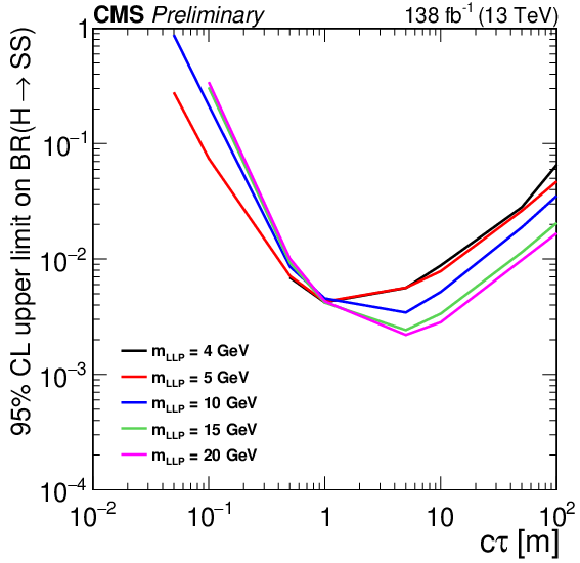
png pdf |
Additional Figure 5-b:
The 95% CL observed upper limits on the branching fraction $ \mathcal{B}(\mathrm{h}^0\to\Psi\Psi) $ as functions of $ c\tau $ for the Higgs portal, assuming $ x_{i\omega} = x_{i\Lambda} = $ 1.0 (left), $ x_{i\omega} = 2.5, x_{i\Lambda} = $ 1.0 (center), and $ x_{i\omega} = x_{i\Lambda} = $ 2.5 (right). The exclusion limits are shown for different mass hypotheses: 4, 5, 10, 15, and 20 GeV. |
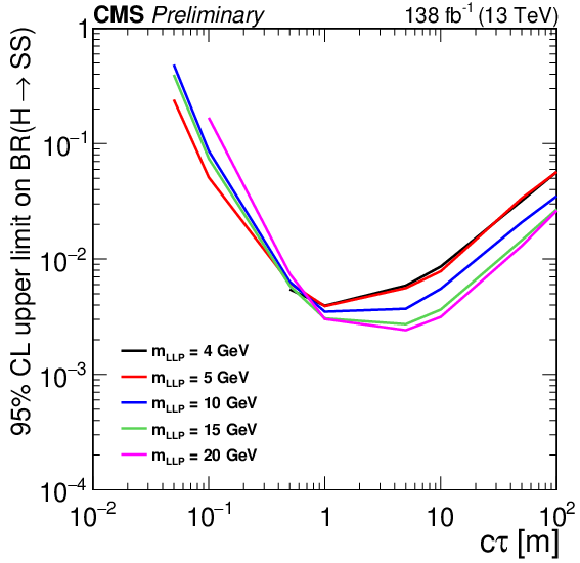
png pdf |
Additional Figure 5-c:
The 95% CL observed upper limits on the branching fraction $ \mathcal{B}(\mathrm{h}^0\to\Psi\Psi) $ as functions of $ c\tau $ for the Higgs portal, assuming $ x_{i\omega} = x_{i\Lambda} = $ 1.0 (left), $ x_{i\omega} = 2.5, x_{i\Lambda} = $ 1.0 (center), and $ x_{i\omega} = x_{i\Lambda} = $ 2.5 (right). The exclusion limits are shown for different mass hypotheses: 4, 5, 10, 15, and 20 GeV. |

png pdf |
Additional Figure 6:
The 95% CL observed upper limits on the branching fraction $ \mathcal{B}(\mathrm{h}^0\to\Psi\Psi) $ as functions of $ c\tau $ for the dark photon portal, assuming $ x_{i\omega} = x_{i\Lambda} = $ 1.0 (left), $ x_{i\omega} = 2.5, x_{i\Lambda} = $ 1.0 (center), and $ x_{i\omega} = x_{i\Lambda} = $ 2.5 (right). The exclusion limits are shown for different mass hypotheses: 5, 10, 15, and 20 GeV. |
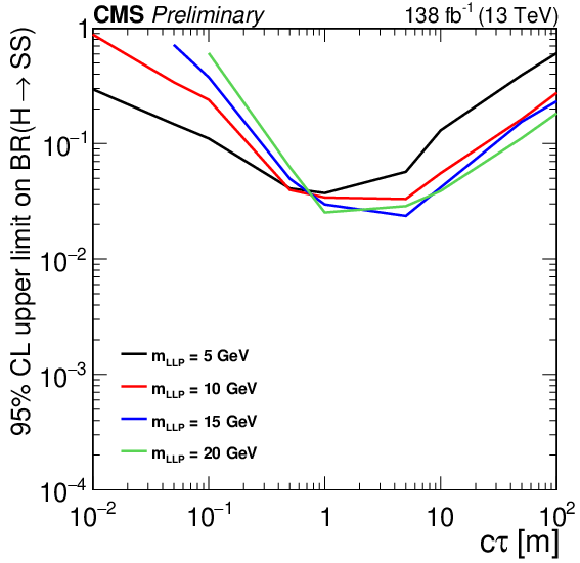
png pdf |
Additional Figure 6-a:
The 95% CL observed upper limits on the branching fraction $ \mathcal{B}(\mathrm{h}^0\to\Psi\Psi) $ as functions of $ c\tau $ for the dark photon portal, assuming $ x_{i\omega} = x_{i\Lambda} = $ 1.0 (left), $ x_{i\omega} = 2.5, x_{i\Lambda} = $ 1.0 (center), and $ x_{i\omega} = x_{i\Lambda} = $ 2.5 (right). The exclusion limits are shown for different mass hypotheses: 5, 10, 15, and 20 GeV. |
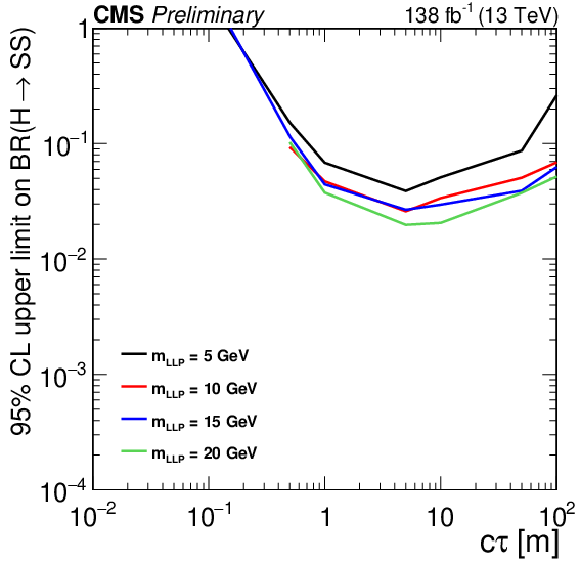
png pdf |
Additional Figure 6-b:
The 95% CL observed upper limits on the branching fraction $ \mathcal{B}(\mathrm{h}^0\to\Psi\Psi) $ as functions of $ c\tau $ for the dark photon portal, assuming $ x_{i\omega} = x_{i\Lambda} = $ 1.0 (left), $ x_{i\omega} = 2.5, x_{i\Lambda} = $ 1.0 (center), and $ x_{i\omega} = x_{i\Lambda} = $ 2.5 (right). The exclusion limits are shown for different mass hypotheses: 5, 10, 15, and 20 GeV. |

png pdf |
Additional Figure 6-c:
The 95% CL observed upper limits on the branching fraction $ \mathcal{B}(\mathrm{h}^0\to\Psi\Psi) $ as functions of $ c\tau $ for the dark photon portal, assuming $ x_{i\omega} = x_{i\Lambda} = $ 1.0 (left), $ x_{i\omega} = 2.5, x_{i\Lambda} = $ 1.0 (center), and $ x_{i\omega} = x_{i\Lambda} = $ 2.5 (right). The exclusion limits are shown for different mass hypotheses: 5, 10, 15, and 20 GeV. |
| References | ||||
| 1 | G. F. Giudice and A. Romanino | Split supersymmetry | NPB 699 (2004) 65 | hep-ph/0406088 |
| 2 | J. L. Hewett, B. Lillie, M. Masip, and T. G. Rizzo | Signatures of long-lived gluinos in split supersymmetry | JHEP 09 (2004) 070 | hep-ph/0408248 |
| 3 | N. Arkani-Hamed, S. Dimopoulos, G. F. Giudice, and A. Romanino | Aspects of split supersymmetry | NPB 709 (2005) 3 | hep-ph/0409232 |
| 4 | P. Gambino, G. F. Giudice, and P. Slavich | Gluino decays in split supersymmetry | NPB 726 (2005) 35 | hep-ph/0506214 |
| 5 | A. Arvanitaki, N. Craig, S. Dimopoulos, and G. Villadoro | Mini-split | JHEP 02 (2013) 126 | 1210.0555 |
| 6 | N. Arkani-Hamed et al. | Simply unnatural supersymmetry | 1212.6971 | |
| 7 | P. Fayet | Supergauge invariant extension of the Higgs mechanism and a model for the electron and its neutrino | NPB 90 (1975) 104 | |
| 8 | G. R. Farrar and P. Fayet | Phenomenology of the production, decay, and detection of new hadronic states associated with supersymmetry | PLB 76 (1978) 575 | |
| 9 | S. Weinberg | Supersymmetry at ordinary energies. Masses and conservation laws | PRD 26 (1982) 287 | |
| 10 | R. Barbier et al. | $ R $-parity violating supersymmetry | Phys. Rept. 420 (2005) 1 | hep-ph/0406039 |
| 11 | G. F. Giudice and R. Rattazzi | Theories with gauge mediated supersymmetry breaking | Phys. Rept. 322 (1999) 419 | hep-ph/9801271 |
| 12 | P. Meade, N. Seiberg, and D. Shih | General gauge mediation | Prog. Theor. Phys. Suppl. 177 (2009) 143 | 0801.3278 |
| 13 | M. Buican, P. Meade, N. Seiberg, and D. Shih | Exploring general gauge mediation | JHEP 03 (2009) 016 | 0812.3668 |
| 14 | J. Fan, M. Reece, and J. T. Ruderman | Stealth supersymmetry | JHEP 11 (2011) 012 | 1105.5135 |
| 15 | J. Fan, M. Reece, and J. T. Ruderman | A stealth supersymmetry sampler | JHEP 07 (2012) 196 | 1201.4875 |
| 16 | M. J. Strassler and K. M. Zurek | Echoes of a hidden valley at hadron colliders | PLB 651 (2007) 374 | hep-ph/0604261 |
| 17 | M. J. Strassler and K. M. Zurek | Discovering the Higgs through highly-displaced vertices | PLB 661 (2008) 263 | hep-ph/0605193 |
| 18 | T. Han, Z. Si, K. M. Zurek, and M. J. Strassler | Phenomenology of hidden valleys at hadron colliders | JHEP 07 (2008) 008 | 0712.2041 |
| 19 | Y. Cui, L. Randall, and B. Shuve | A WIMPy baryogenesis miracle | JHEP 04 (2012) 075 | 1112.2704 |
| 20 | Y. Cui and R. Sundrum | Baryogenesis for weakly interacting massive particles | PRD 87 (2013) 116013 | 1212.2973 |
| 21 | Y. Cui and B. Shuve | Probing baryogenesis with displaced vertices at the LHC | JHEP 02 (2015) 049 | 1409.6729 |
| 22 | D. Smith and N. Weiner | Inelastic dark matter | PRD 64 (2001) 043502 | hep-ph/0101138 |
| 23 | Z. Chacko, H.-S. Goh, and R. Harnik | Natural electroweak breaking from a mirror symmetry | PRL 96 (2006) 231802 | hep-ph/0506256 |
| 24 | D. Curtin and C. B. Verhaaren | Discovering uncolored naturalness in exotic Higgs decays | JHEP 12 (2015) 072 | 1506.06141 |
| 25 | H.-C. Cheng, S. Jung, E. Salvioni, and Y. Tsai | Exotic quarks in twin Higgs models | JHEP 03 (2016) 074 | 1512.02647 |
| 26 | CMS Collaboration | The CMS muon project: Technical Design Report | CERN-LHCC-97-032, CMS-TDR-3, 1997 CDS |
|
| 27 | CMS Collaboration | The CMS experiment at the CERN LHC | JINST 3 (2008) S08004 | |
| 28 | N. Craig, A. Katz, M. Strassler, and R. Sundrum | Naturalness in the dark at the LHC | JHEP 07 (2015) 105 | 1501.05310 |
| 29 | M. J. Strassler | On the phenomenology of hidden valleys with heavy flavor | 0806.2385 | |
| 30 | J. E. Juknevich, D. Melnikov, and M. J. Strassler | A pure-glue hidden valley I. states and decays | JHEP 07 (2009) 055 | 0903.0883 |
| 31 | CMS Collaboration | Search for long-lived particles using displaced jets in proton-proton collisions at $ \sqrt{s} = $ 13 TeV | PRD 104 (2021) 012015 | CMS-EXO-19-021 2012.01581 |
| 32 | ATLAS Collaboration | Search for long-lived particles produced in $ pp $ collisions at $ \sqrt{s}= $ 13 TeV that decay into displaced hadronic jets in the ATLAS muon spectrometer | PRD 99 (2019) 052005 | 1811.07370 |
| 33 | ATLAS Collaboration | Search for events with a pair of displaced vertices from long-lived neutral particles decaying into hadronic jets in the ATLAS muon spectrometer in pp collisions at $ \sqrt s = $ 13 TeV | PRD 106 (2022) 032005 | 2203.00587 |
| 34 | CMS Collaboration | Search for Long-Lived Particles Decaying in the CMS End Cap Muon Detectors in Proton-Proton Collisions at $ \sqrt s $ =13 TeV | PRL 127 (2021) 261804 | CMS-EXO-20-015 2107.04838 |
| 35 | S. Knapen, J. Shelton, and D. Xu | Perturbative benchmark models for a dark shower search program | PRD 103 (2021) 115013 | 2103.01238 |
| 36 | CMS Collaboration | Performance of the CMS cathode strip chambers with cosmic rays | JINST 5 (2010) T03018 | CMS-CFT-09-011 0911.4992 |
| 37 | CMS Collaboration | Performance of the CMS Level-1 trigger in proton-proton collisions at $ \sqrt{s} = $ 13 TeV | JINST 15 (2020) P10017 | CMS-TRG-17-001 2006.10165 |
| 38 | CMS Collaboration | The CMS trigger system | JINST 12 (2017) P01020 | CMS-TRG-12-001 1609.02366 |
| 39 | P. Nason | A new method for combining NLO QCD with shower Monte Carlo algorithms | JHEP 11 (2004) 040 | hep-ph/0409146 |
| 40 | S. Frixione, P. Nason, and C. Oleari | Matching NLO QCD computations with parton shower simulations: the POWHEG method | JHEP 11 (2007) 070 | 0709.2092 |
| 41 | S. Alioli, P. Nason, C. Oleari, and E. Re | A general framework for implementing NLO calculations in shower Monte Carlo programs: the POWHEG \textscbox | JHEP 06 (2010) 043 | 1002.2581 |
| 42 | E. Re | Single-top $ \mathrm{W}\mathrm{t} $-channel production matched with parton showers using the POWHEG method | EPJC 71 (2011) 1547 | 1009.2450 |
| 43 | L. Carloni, J. Rathsman, and T. Sjöstrand | Discerning Secluded Sector gauge structures | JHEP 04 (2011) 091 | 1102.3795 |
| 44 | L. Carloni and T. Sjöstrand | Visible Effects of Invisible Hidden Valley Radiation | JHEP 09 (2010) 105 | 1006.2911 |
| 45 | T. Sjöstrand et al. | An introduction to PYTHIA 8.2 | Comput. Phys. Commun. 191 (2015) 159 | 1410.3012 |
| 46 | CMS Collaboration | Event generator tunes obtained from underlying event and multiparton scattering measurements | EPJC 76 (2016) 155 | CMS-GEN-14-001 1512.00815 |
| 47 | CMS Collaboration | Extraction and validation of a new set of CMS PYTHIA8 tunes from underlying-event measurements | EPJC 80 (2020) 4 | CMS-GEN-17-001 1903.12179 |
| 48 | NNPDF Collaboration | Parton distributions for the LHC Run II | JHEP 04 (2015) 040 | 1410.8849 |
| 49 | NNPDF Collaboration | Parton distributions from high-precision collider data | EPJC 77 (2017) 663 | 1706.00428 |
| 50 | GEANT4 Collaboration | GEANT 4---a simulation toolkit | NIM A 506 (2003) 250 | |
| 51 | CMS Collaboration | Particle-flow reconstruction and global event description with the CMS detector | JINST 12 (2017) P10003 | CMS-PRF-14-001 1706.04965 |
| 52 | CMS Collaboration | Performance of the CMS muon detector and muon reconstruction with proton-proton collisions at $ \sqrt{s}= $ 13 TeV | JINST 13 (2018) P06015 | CMS-MUO-16-001 1804.04528 |
| 53 | M. Cacciari, G. P. Salam, and G. Soyez | The anti-$ k_{\mathrm{T}} $ jet clustering algorithm | JHEP 04 (2008) 063 | 0802.1189 |
| 54 | M. Cacciari, G. P. Salam, and G. Soyez | FASTJET user manual | EPJC 72 (2012) 1896 | 1111.6097 |
| 55 | CMS Collaboration | Jet energy scale and resolution in the CMS experiment in pp collisions at 8 TeV | JINST 12 (2017) P02014 | CMS-JME-13-004 1607.03663 |
| 56 | CMS Collaboration | Performance of missing transverse momentum reconstruction in proton-proton collisions at $ \sqrt{s} = $ 13 TeV using the CMS detector | JINST 14 (2019) P07004 | CMS-JME-17-001 1903.06078 |
| 57 | M. Ester, H.-P. Kriegel, J. Sander, and X. Xu | A density-based algorithm for discovering clusters in large spatial databases with noise | in Proceedings of the Second International Conference on Knowledge Discovery and Data Mining. Association for the Advancement of Artificial Intelligence, 1996 link |
|
| 58 | CMS Collaboration | Missing transverse energy performance of the CMS detector | JINST 6 (2011) P09001 | CMS-JME-10-009 1106.5048 |
| 59 | CMS Collaboration | Performance of the reconstruction and identification of high-momentum muons in proton-proton collisions at $ \sqrt{s} = $ 13 TeV | JINST 15 (2020) P02027 | CMS-MUO-17-001 1912.03516 |
| 60 | CMS Collaboration | Precision luminosity measurement in proton-proton collisions at $ \sqrt{s} = $ 13 TeV in 2015 and 2016 at CMS | EPJC 81 (2021) 800 | CMS-LUM-17-003 2104.01927 |
| 61 | CMS Collaboration | CMS luminosity measurements for the 2017 data-taking period at $ \sqrt{s} = $ 13 TeV | CMS Physics Analysis Summary, 2017 CMS-PAS-LUM-17-004 |
CMS-PAS-LUM-17-004 |
| 62 | CMS Collaboration | CMS luminosity measurements for the 2018 data-taking period at $ \sqrt{s} = $ 13 TeV | CMS Physics Analysis Summary, 2018 CMS-PAS-LUM-18-002 |
CMS-PAS-LUM-18-002 |
| 63 | T. Junk | Confidence level computation for combining searches with small statistics | NIM A 434 (1999) 435 | hep-ex/9902006 |
| 64 | A. L. Read | Presentation of search results: the CL$ _\mathrm{s} $ technique | JPG 28 (2002) 2693 | |
| 65 | The ATLAS Collaboration, The CMS Collaboration, The LHC Higgs Combination Group | Procedure for the LHC Higgs boson search combination in Summer 2011 | \unskip\space CMS-NOTE-2011-005, ATL-PHYS-PUB-2011-11, 2011 | |
| 66 | G. Cowan, K. Cranmer, E. Gross, and O. Vitells | Asymptotic formulae for likelihood-based tests of new physics | EPJC 71 (2011) 1554 | 1007.1727 |
| 67 | Y. Gershtein, S. Knapen, and D. Redigolo | Probing naturally light singlets with a displaced vertex trigger | PLB 823 (2021) 136758 | 2012.07864 |

|
Compact Muon Solenoid LHC, CERN |

|

|

|

|

|

|